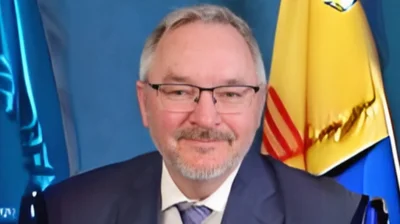Victor Acosta, an associate professor in the Department of Physics and Astronomy at The University of New Mexico, has been named a 2024 Experimental Physics Investigator by the Gordon and Betty Moore Foundation. Acosta will receive a five-year $1.25 million research grant to investigate the true limits of precision measurement. He is one of 19 researchers to receive this award.
Acosta’s project will focus on precision measurement of nitrogen-vacancy centers in diamond. His research team aims to develop methods for precision metrology that could lead to significant gains in measurement sensitivity.
“This particular research project is focused on using nitrogen-vacancy centers in diamonds, essentially defects that have unique optical and magnetic properties, to push the frontier of the precision measurement field,” Acosta said. “This award frees our team to pursue curiosity-driven research, which will allow us to explore the limits of the field and see what is possible.”
The Moore Foundation award is designed for mid-career physicists who have recently received tenure, allowing experienced researchers to investigate new questions with flexibility.
The synthetic diamonds used in Acosta’s research differ from those used in jewelry. These diamonds look more like glass rectangles and often have higher fluorescence. They play a crucial role in advancing physics research.
Potential applications of this research include detecting magnetic fields produced by neuronal currents in the brain, nuclear magnetic resonance spectroscopy chemical analysis, and possibly searching for new particles that could explain dark matter.
The team will study methods such as suppressing microwave noise impact, using magnetic flux concentrators, and analyzing energy level dynamics of nitrogen-vacancy centers to improve optical readout systems. This approach was originally utilized by atomic clock and magnetic resonance communities.
"I'm so impressed by the wide range of precision measurement applications we should see from nitrogen-vacancy centers in diamond, all the way from medical applications to maybe looking for dark matter. Dr. Acosta’s planned research could lead to enormous improvements in that precision, bringing these goals closer to reality,” Richard Rand, chair of the Department of Physics and Astronomy, said.
Acosta acknowledged collaborations with other researchers and students in his lab as foundational for this work. He thanked Janis Smits for developing diamond nuclear magnetic resonance spectroscopy; Yaser Silani for work on magnetic flux concentrators and radio-frequency magnetometry; Maziar Saleh Ziabari for efforts in phase noise spectroscopy and isotropic flux concentration; and Andris Berzins for recent work on magnetic gradiometry and infrared absorption spectroscopy.
The Moore Foundation seeks to build a community of experimental physicists by funding new cohorts each year. This is the third year of the program. More information about the award can be found on the Moore Foundation website.









